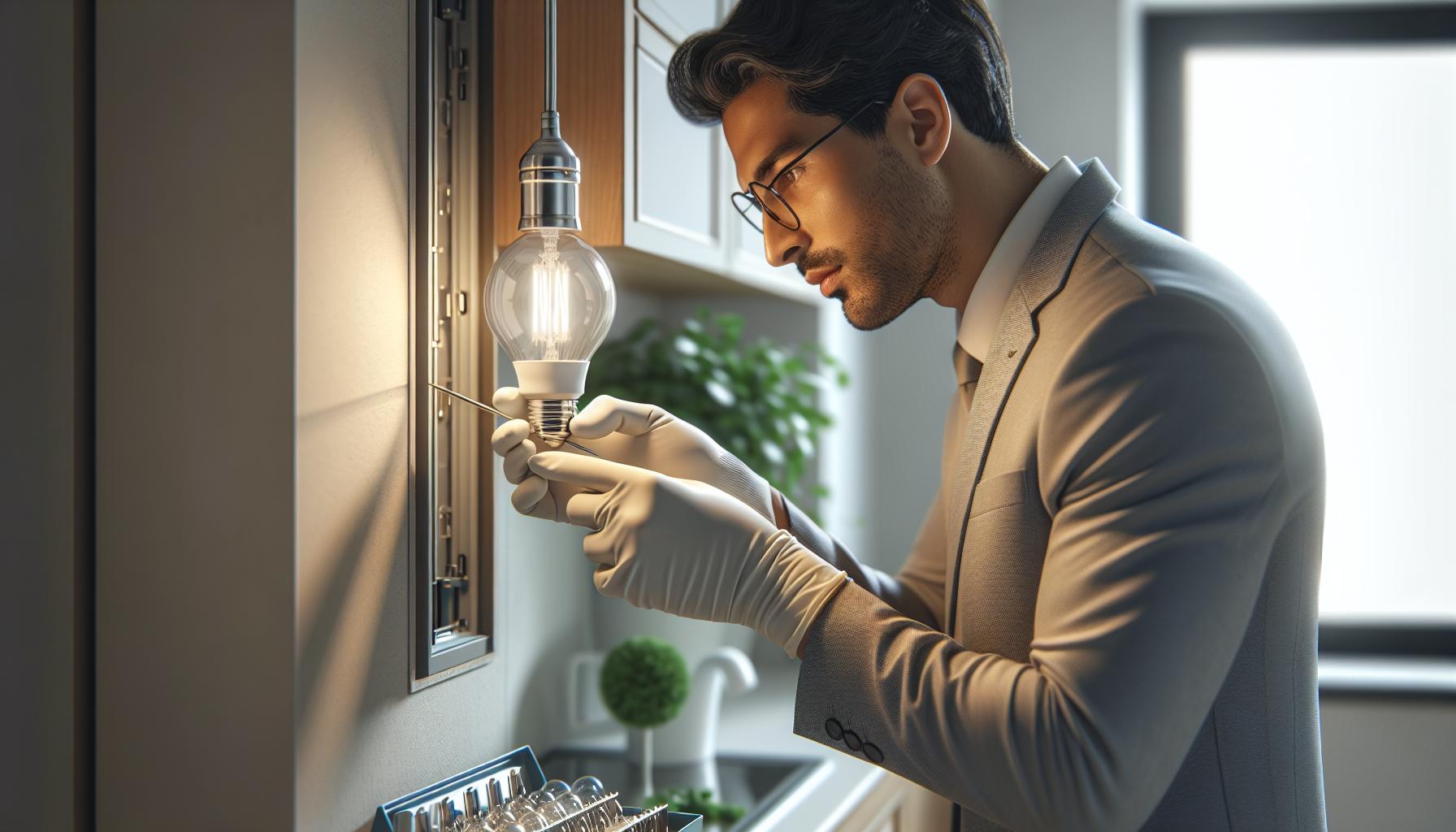Ever wondered why some light bulbs come with a strict “Do Not Touch” warning? It turns out, the oils from your fingers can do more than just leave smudges—they can shorten a bulb’s lifespan or even cause it to shatter. Let’s shed some light on the bulbs that need a hands-off approach.
Halogen bulbs are the usual suspects when it comes to sensitivity. These high-temperature bulbs can overheat with the slightest residue from your skin. But they’re not alone in the no-touch zone. Certain eco-friendly bulbs and high-intensity discharge lamps also prefer a clean, untouched surface to perform their best.
Knowing which bulbs to handle with care can save you from unexpected darkness and the hassle of premature bulb shopping. Stick around as we illuminate the types of bulbs that demand a little extra caution and why your touch can be their untimely end.
Why Do Some Light Bulbs Have a “Do Not Touch” Warning?
Have you ever picked up a light bulb and noticed a “Do Not Touch” warning? It’s not just there for show. Certain types of light bulbs are highly sensitive to the oils and dirt that naturally occur on human skin. When you’re elbow-deep in your latest DIY home project, the last thing you think about is how clean your hands are before swapping out a bulb.
Let’s talk about halogen bulbs, the divas of the lighting world. They operate at much higher temperatures, and any residue from your fingers can create a hotspot on the bulb’s surface. Over time, this leads to a shortened lifespan or, in unfortunate scenarios, causes the bulb to shatter. High-intensity discharge lamps are no different—handling them with bare hands is a big no-no.
Even eco-friendly bulbs aren’t immune to the detriments of direct touch. Though they don’t heat up as much, the oils can still affect their delicate coatings and filaments, which are essential for energy efficiency and full brightness.
Managing which bulbs necessitate a hands-off method is key to avoiding unexpected darkness in the middle of your work and to shun an untimely trip to the store for replacements. When installing these finicky illuminators, always remember:
- Use a clean cloth or gloves when handling.
- Avoid touching the glass part of sensitive bulbs.
- Keep the bulb free from contaminants to ensure its longevity.
Getting familiar with the types of bulbs that demand careful handling isn’t just about following rules—it’s about protecting your investment in bright, energy-efficient lighting for your home. Remember, not all bulbs are created equal, and when it comes to sensitive lighting solutions, treat them with the TLC they deserve.
The Harmful Effects of Touching Light Bulbs
When it comes to maintaining the efficiency and lifespan of your lighting, understanding the harmful effects of direct contact with light bulbs is crucial. Oils from your skin can drastically alter the performance and safety of certain bulb types.
For halogen bulbs in particular, the heat distribution is critical for their operation. When you touch the glass, the oils create hot spots which may lead to the bulb overheating or causing the glass to weaken and eventually rupture. This isn’t just an issue of longevity; it’s a safety concern too.
With high-intensity discharge (HID) lamps, the story is somewhat similar. These bulbs work under high pressure and temperature. When contaminated with fingerprints or dirt, the balance is disturbed, potentially leading to premature failure or, in some cases, bursting. It’s not something you want happening at home, especially during your DIY projects where safety is paramount.
Eco-friendly bulbs, like CFLs (Compact Fluorescent Lamps) and LEDs, may not be as prone to bursting due to touching, but their lifespan is also affected. The contaminants can interfere with the electronic components, shortening the bulb’s useful life and dimming over time, which is antithetical to their purpose of being energy-efficient.
To keep your bulbs in top-notch condition, here are a few handling tips:
- Always switch off the power before attempting to change a bulb.
- If a bulb is hot, allow it to cool before handling to avoid burns.
- Utilize a lint-free cloth or gloves when installing to prevent direct contact.
- Be gentle; rough handling can damage the delicate filaments or electronics.
« Are Dimmable Light Bulbs the Same as 3-Way? Unveil Their True Differences
Do Light Bulbs Have to Be the Same Wattage? Unlock the Secret to Perfect Lighting »
By adhering to these simple yet effective measures, you’ll ensure that your lights not only shine brightly but also contribute to a safe and efficiently-run household. Remember, the way you handle your bulbs can have a significant impact on their performance. So next time, before reaching for that light fixture, make sure to pause and prepare accordingly.
Types of Light Bulbs that Should Not be Touched
As you delve deeper into the realm of home lighting and initiate your DIY projects, it’s vital to recognize which bulbs demand a hands-off approach. Understanding the different bulbs that fall under this category will not only protect the bulbs but will ensure your safety as well.
Halogen Bulbs are incredibly sensitive to skin oils and should never be touched with bare hands. The heat generated by these bulbs is significant, and when combined with oils from your skin, it can lead to an uneven temperature on the bulb’s surface, eventually causing it to weaken or even shatter.
High-Intensity Discharge (HID) Lamps, used for their brightness and efficiency, especially in larger spaces, also can’t stand the touch of human hands. The salts and compounds inside HID lamps may degrade when in contact with oils and moisture, often resulting in reduced lifespan and lower performance.
Moving to eco-friendly options, CFLs (Compact Fluorescent Lamps) and certain types of LEDs may not suffer from the dramatic temperature issues of halogen or HID lamps, but touching them can still lead to an early grave for these energy-saving illuminators. The delicate electronics and phosphor coating inside CFLs particularly dislike any residues from your hands, affecting their efficiency and potentially shortening their lifespan.
Furthermore, consider specialty bulbs such as neodymium incandescent bulbs often used to mimic daylight. These bulbs have a special coating that you’ll want to keep intact. By avoiding direct contact, you’re ensuring the longevity of the bulb’s life and its full spectrum lighting capability.
For safe handling, always turn off the power first and wait for the bulbs to cool. Opt for a lint-free cloth or wear gloves to grip the bulb firmly but gently. Remember, your touch might have more impact than you think on the intricate world of light bulbs. By acknowledging the limits of your influence, you’re taking a step towards a brighter, more efficient home. Keep these tips in your back pocket as you carefully navigate your lighting projects.
Halogen Bulbs: Fragile and Sensitive to Touch
As an expert who revels in the intricacies of home DIY projects, you’ve likely encountered the allure of halogen bulbs. These little powerhouses are known for their crisp, white light and remarkable efficiency. But have you ever stopped to ponder why these bulbs seem to have a “Handle with Care” sign invisibly etched on their surfaces?
Halogen bulbs are a marvel of lighting technology, but beneath that glowing facade lies a susceptibility to the oils from your skin. This isn’t just a minor inconvenience; it’s a critical aspect of their design. When you touch a halogen bulb with your bare hands, you inadvertently leave behind an oily residue. This might seem harmless at first glance, but it’s actually the prelude to a reduced lifespan for your bulb.
The reason for this sensitivity is the halogen cycle, a chemical reaction that occurs within the bulb. The cycle relies on the bulb’s temperature remaining consistent. When you touch its surface, the oil from your skin creates a hotspot which disrupts this cycle. This can lead to a situation where the bulb works less effectively, and worse, it can cause the bulb to fail prematurely.
Here are a few handling tips to keep your halogen bulbs shining bright:
- Use gloves or a clean, dry cloth whenever you need to replace or adjust a halogen bulb.
- Ensure the light is switched off and the bulb is cool to the touch before you proceed.
- If you do accidentally contact the bulb with bare hands, gently clean it with rubbing alcohol and a soft cloth to remove any oils.
Eco-friendly Bulbs and High-Intensity Discharge Lamps: Handle with Care
When you’re trying to both brighten up your home and maintain an eco-friendly outlook, you might lean towards Compact Fluorescent Lamps (CFLs) or Light Emitting Diodes (LEDs). However, just like their halogen cousins, these bulbs have a sensitive side that demands attention.
CFLs are the curly versions of long tube fluorescent lamps. While they use less energy, they contain a small amount of mercury, making them a bit more delicate. If you’ve ever accidentally dropped one, you know the mini panic attack that follows – the scramble to air out the room and clean up the hazardous materials safely is no one’s idea of a good time.
With LEDs, although sturdier and almost unbreakable, you still need to be aware of oils from your skin affecting the diodes and dimming the bright future ahead. Given their long lifespan, any residue can accumulate over time, dimming the bulb’s performance.
Then we have High-Intensity Discharge (HID) lamps, the heavy hitters of the lighting world. They provide a massive amount of light and are often used in larger spaces, like warehouses or stadiums. HIDs produce light by creating an electric arc between tungsten electrodes, a method that makes them incredibly efficient. Here’s what you need to know when handling these lamps:
- Never touch the HID bulbs with your bare hands, especially when installing or cleaning. Use gloves to prevent skin oils from interfering with the lamp’s operation.
- Ensure the bulb has cooled down entirely before attempting to replace or adjust it to avoid burns or accidental shattering.
Remember, no matter the type of eco-friendly or high-intensity bulb you’re dealing with, a bit of precaution goes a long way. Keep your bulbs clean, handle them with care, and you’ll continue reaping the benefits of a well-lit, energy-efficient space for years to come.
Conclusion
So now you’ve got the lowdown on keeping your bulbs bright and efficient. Remember, a little caution goes a long way in extending the life of your lighting. Embrace those eco-friendly habits and handle your bulbs with care. Your diligence not only saves you time and money but also contributes to a greener planet. Light up your space wisely, and those bulbs will shine on for many bright days ahead!
Frequently Asked Questions
Can touching a halogen bulb with bare hands shorten its lifespan?
Yes, the oils from your skin can cause hot spots on a halogen bulb, leading to a shorter lifespan. It is recommended to handle them with clean gloves or a cloth.
What happens if you touch a CFL bulb?
Touching a Compact Fluorescent Lamp (CFL) generally does not affect its lifespan as it does with halogen bulbs. However, it’s still best to handle them carefully to avoid breakage.
Is it safe to touch an LED bulb?
While LEDs are less sensitive to touch, it is still advisable to handle them with care to prevent damage to the bulb. Using gloves can protect them from potential contaminants.
Does touching an HID lamp affect its performance?
Yes, touching an HID lamp with bare hands can leave behind oils that may affect its performance. It’s important to handle these lamps with clean gloves or a cloth.
What general precautions should be taken when handling light bulbs?
Regardless of the bulb type, ensure the bulb is cool before handling, use gloves or a cloth to avoid direct contact with your skin, and never apply pressure to the glass surface.





